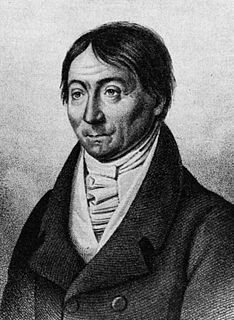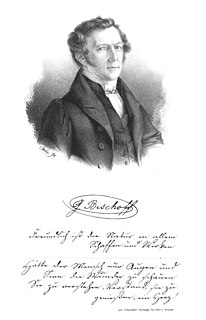Related Research Articles

Martin Hinrich Carl Lichtenstein was a German physician, explorer, botanist and zoologist.

Heinrich Gustav Reichenbach was a botanist and the foremost German orchidologist of the 19th century. His father Heinrich Gottlieb Ludwig Reichenbach was also a well-known botanist.

Johann Heinrich Friedrich Link was a German naturalist and botanist. The standard author abbreviation Link is used to indicate this person as the author when citing a botanical name.

Friedrich Anton Wilhelm Miquel was a Dutch botanist, whose main focus of study was on the flora of the Dutch East Indies.

Jacob Sturm was a leading engraver of entomological and botanical scientific publications in Germany at the end of the 18th and beginning of the 19th century. He was born and lived in Nuremberg and was the only son of engraver Johann Georg Sturm (1742-1793), who trained him in drawing and copperplate engraving.

Julius Theodor Christian Ratzeburg was a German zoologist, botanist, entomologist, and forester.
Christian Friedrich Ecklon was a Danish botanical collector and apothecary. Ecklon is especially known for being an avid collector and researcher of plants in South Africa.

Christian Ferdinand Friedrich Krauss, was a German scientist, traveler and collector.
Friedrich Wilhelm Klatt was a German botanist who specialised in the study of African plants.
Karl Wilhelm von Dalla Torre was an Austrian taxonomist, entomologist and botanist.
Friedrich Karl Max Vierhapper was an Austrian plant collector, botanist and professor of botany at the University of Vienna. He was the son of amateur botanist Friedrich Vierhapper (1844–1903), botanical abbreviation- "F.Vierh.".
Wilhelm Ludwig Ewald Schmidt was a German physician, botanist, and entomologist. As an entomologist, he specialized in Coleoptera.

The Botanical Garden of TU Darmstadt is a botanical garden maintained by the Technische Universität Darmstadt.

A Musen-Almanach was a kind of literary annual, popular in Germany from 1770 into the mid-19th century. They were modelled on the Almanach des Muses published in Paris from 1765.
Friedrich Wilhelm Gottlieb Theophil Rostkovius (1770–1848) was a German physician, mycologist and botanist.
Friedrich Markgraf was a German botanist.
Anton Wilhelm Plaz was a German physician and botanist.
Plantae preissianae sive enumeratio plantarum quas in australasia occidentali et meridionali-occidentali annis 1838-1841 collegit Ludovicus Preiss, more commonly known as Plantae preissianae, is a book written by Johann Georg Christian Lehmann and Ludwig Preiss.

Gottlieb Wilhelm Bischoff was a German botanist and university professor. He was among the first to examine the reproduction of mosses and liverworts, and is credited with coining the terms archegonia and antheridia.
References
- ↑ IPNI. J.A.Schmidt.